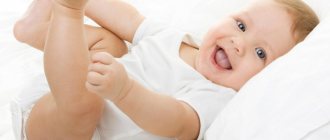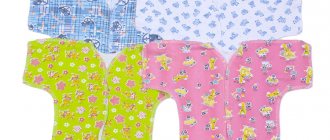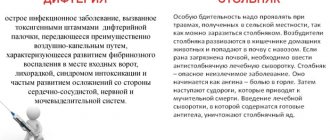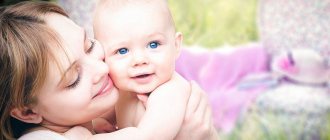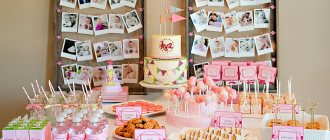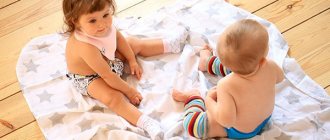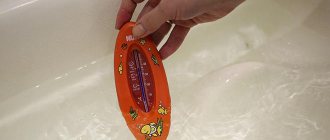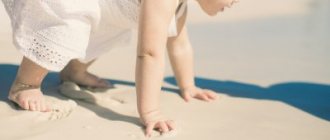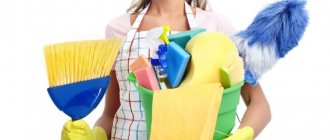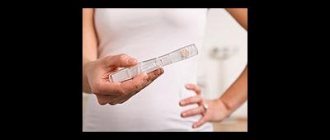Basic rules of baby hygiene in the first days at home
- As you know, girls and boys are built differently. Moreover, a newborn baby has its own characteristics, which are important to consider when caring for it. Until about 3-5 years of age, the head of the penis is tightly covered by the foreskin. This must be taken into account when bathing, so as not to harm the child’s health.
- The first full bathing is carried out after the umbilical wound has healed, so that infection and inflammation do not occur. Daily hygiene up to this point boils down to washing and wiping areas of the body with a damp towel.
- At first, you don’t need detergents or washcloths for bathing, just warm, clean water is enough.
- Bathing during the newborn period is not so much hygienic as a relaxing and adaptation procedure, so 2-3 times a week will be enough.
- Have you been vaccinated? Do not bathe your baby for 3-4 days so as not to provoke complications.
Baby hygiene products - to wash or not to wash?
Today, store shelves are full of all kinds of baby hygiene products: gels for bathing, washing and rinsing, baby shampoos and soaps. Let's take a closer look at when you can start using such products and how to choose a quality product.
Detergents for children - when to start using
Modern pediatrics recommends using baby foam from the very birth of the baby. At the same time, be sure to pay attention to the information on the packaging - such products contain a minimum of dyes and flavors, which are often added to detergents for older children.
It is better to postpone the use of soap until the child reaches 3–4 months . The reason for this is the alkaline environment that soap creates on the surface of the skin: it is detrimental to the beneficial bacteria of the epidermis that live in an acidic environment. Often using baby soap, we violate the natural protection of the child's skin.
The “no tears” label in addition to the “0+” designation indicates a minimum of aggressive ingredients
How to choose baby detergent
Today, even in children's detergents you can find aggressive substances that unscrupulous manufacturers use to replace more expensive, relatively safe products. To protect your baby from the toxic effects of poor-quality products, it is necessary to carefully study the composition.
So, high-quality and fairly safe detergents for children should not contain the following harmful substances.
- Glycerol. Contrary to popular belief about its moisturizing properties, glycerin actually draws water from the deep layers of the skin, increasing dehydration.
- Sodium lauryl and laureth sulfate (Sodium Lauryl Sulfate, Laureth Sulfate, SLS, SLES). Another name for these substances is surfactants; they are able to completely “kill” the beneficial bacteria of the child’s epidermis, increasing the harmful effects of prolonged exposure to the skin (to wash off the surfactants, you need to rinse in clean cold water at least 15 times, which is simply impossible to do with a child).
- Mineral oil (Mineral oil, Paraffinum, paraffin. Petrolatum). Petroleum products, due to their low cost, are often used in the manufacture of cosmetics. They create a film on the skin that prevents it from breathing, thereby creating conditions for irritation, inflammation, and prickly heat.
- Diethanolamine (DEA). A substance “responsible” for the amount and durability of foam. In itself, it is not considered a carcinogen, but it can form nitrosadiethanolamine, a substance that causes stomach cancer.
- Propylene-Glycol, PEG, PEG. And also made from petroleum products, like glycerin, binds water and promotes dehydration. In high concentrations it causes hepatic and renal disorders. Unfortunately, propylene glycol is added in significant dosages to detergents for children.
- Triclosan. It has antibacterial properties that have a detrimental effect on beneficial bacteria of the epidermis. When mixed with chlorine contained in tap water, it can create the substance chloroform, which is dangerous to the health of a child.
Bathing for the first time
It is more convenient to bathe the baby in a special baby bath , which can be installed on a changing table or stools. In this case, the adult does not need to bend over excessively to perform the manipulations. In addition, it will take less water to fill a small container. If there is no such bath, it is quite acceptable to bathe the baby in a washed adult bath.
What needs to be prepared?
Towel
There are special children's bathing towels on sale. The shape of the product resembles a square with an additional “pocket” at one of the corners. After bathing, such a corner comfortably covers the baby’s head, and the rest of the cloth should be wrapped around the body.
The texture of children's towels is more delicate, the terry weave is smaller and thinner. Such products absorb moisture well and are more pleasant for the baby’s thin skin. This is an important factor. The skin of a newborn is several times thinner than the epidermis of an adult ; wet skin cannot be rubbed - neither with a washcloth nor with a cloth. After bathing, the moisture should be blotted with a dry, clean towel, without rubbing or applying pressure.
If you have not purchased such a towel, you can use a large soft bath towel or a soft, thick flannel diaper. Additionally, prepare a small towel or cloth to blot your face.
Important! Children's bath towels do not need to be washed at high temperatures, boiled, bleached or ironed.
Such manipulations will quickly ruin the structure of the fibers. The towel will become rough and lose its absorbency.
Wash baby clothes separately with a neutral detergent. It is permissible to use a special fragrance-free conditioner. There is no need to iron the towels, since the iron “nails” the bulk fibers, which make the terry towel fluffy and airy. Deformed fibers absorb water much worse. Spin towels at low speed. After washing, shake the product and hang it flat to dry away from direct sunlight.
Detergents
At first, a newborn does not need any special means to wash the skin. The baby spends time lying down, does not sweat or get dirty. For the first baths, you only need clean warm water. If you wish, you can add a decoction of the string to the water (1 glass per bath).
A neutral baby bath product will come in handy for bathing later. For the first procedures, universal soft washing substances are produced that replace bath foam, shower gel, mild soap and shampoo.
Signs of a good product:
- transparent (no dyes);
- without a strong aroma (better without any flavorings at all);
- certified for newborns (look for marks on the packaging);
- on a natural soft detergent base (without sulfates);
- without dangerous preservatives (parabens);
- with a convenient dispenser (most often one hand will be free during bathing);
- without intense foam (soft surfactants do not form active foam).
If you prefer soap, buy natural baby soap. Shower gel must meet the same criteria as bathing product. A newborn baby does not need shampoo - the hairs are washed with a universal product.
For daily washing you need baby soap. A liquid product in a large bottle with a dispenser is more convenient. Place a bottle of soap on the sink. Next, empty the hook for a towel, which you will use to blot your skin after washing.
Water
Water temperature – from 33 to 37⁰С . The principle is this: the smaller the bath, the warmer the water. If the baby cannot move, he will freeze in cool water. If bathing is carried out in an adult bath, then the temperature can be reduced by 1⁰C weekly. Thanks to this, the body will be strengthened, and the bathed child will fall asleep faster.
There is no need to boil water. Install filters for incoming tap water. It is permissible to add herbal decoctions to the bath, but this is not necessary - such a measure will not provide any special therapeutic effect, and will add hassle.
Attention! Do not add potassium permanganate and salt to the water. The skin will lose moisture faster.
Additional inventory
For a hygienic procedure, a special stand with an elevation for the head or a foam base for the bath is useful.
If there are no such accessories, place a folded diaper on the bottom to prevent the baby from slipping. If your baby is actively frolicking in a large bathtub, purchase a special circle to keep the head above the water. Buy a thermometer to check the water temperature.
For hygiene procedures after bathing you will need:
- cotton wool;
- cotton pads;
- clean diaper;
- baby cream or powder;
- clean clothes.
Get everything ready before you start swimming. The baby should not be left unattended - all the little things need to be thought through and laid out in advance.
How to wash the foreskin?
Let's look at how to properly wash the genitals of a newborn baby - a boy.
Before circumcision
Until 3-5 years of age, the head of the penis is covered by the foreskin . This condition is called physiological phimosis. Genital hygiene in little boys differs from the principles of sexual hygiene in adult men.
The foreskin should not be forcibly moved, exposing the head. This can lead to injury, inflammation and paraphimosis. Paraphimosis is pinching of the head as a result of forced exposure. The foreskin is not elastic until a certain time, so it puts a lot of pressure on the tissue. This condition requires immediate surgical intervention.
Given the structural features, washing involves caring for the external genitalia . Do not move the foreskin while trying to rinse the glans. Before opening, this area is protected by smegma, which has strong antibacterial properties. If the lubricant is removed, the likelihood of inflammation and infection will increase.
To carry out the hygiene procedure, place the baby with his tummy on the forearm of his left hand. The head should rest on your hand. Place your palm around the baby's right leg. Rinse the genital area and anal fold with warm water.
If the baby is not particularly dirty, you should not use soap every time - delicate skin is covered with a protective fatty lubricant, which is destroyed upon contact with foam. Rinse the groin area from the penis to the butt . Rub the tip of the penis lightly without making any effort. Rinse all folds thoroughly.
If you are afraid to wash your baby under running water, or this is not possible, then wash your baby on the changing table. Dip a small towel or cotton pads into a container of warm water and gently scrub the groin from the genitals to the anus. If there is no water, use wet wipes.
After washing, wet skin should be blotted with a dry cloth. Don't rub. Dry the folds thoroughly.
Leave your baby without a diaper or clothes for 10 minutes if the room is warm. The skin needs air baths.
If you notice irritation, treat the inflamed areas. For wet redness, use powder . For dry skin - baby cream or oil.
After circumcision
After the circumcision procedure, the boy’s foreskin is washed, taking into account additional nuances:
- Every time you change the baby's diaper, you need to wash it with water without soap;
- crusts and films on the surface of the penis should not be disturbed;
- Take special care when drying your skin - find the softest and most absorbent materials possible;
- Protect your skin with Vaseline before putting on a diaper.
Check with your doctor to see if your baby needs to be given anesthetics.
Features of butt care
When washing your butt, you should thoroughly rinse all the folds , directing movements from the genitals to the butt. In case of heavy soiling, additionally use mild, fragrance-free soap. Otherwise, the procedure is similar to regular washing. Until your baby's umbilical wound heals, it is important to ensure that water and detergents do not get on the navel.
How to properly bathe a male baby?
The first bathing in the bath occurs after the baby’s umbilical wound has healed and the umbilical cord has come off - approximately 10-12 days.
Time for the procedure: evening, before the last feeding until bedtime.
Duration of the first procedure: 7-8 minutes (Komarovsky recommends starting with 15 minutes).
Frequency of bathing: 2-3 times a week (according to Komarovsky - every evening).
Do not bathe an irritated or upset baby. Bathing should evoke pleasant associations.
- Prepare everything you need for bathing, hygiene procedures and changing clothes.
- Wash the bathtub with a mild detergent.
- Fill the tub or tub with warm, clean water.
- Add herbal decoction (optional).
- Place a diaper folded in several layers at the bottom of the plastic bath or use a slide, stand or foam backing.
- If you are bathing in a large bathtub, it is permissible to bathe in a special inflatable collar that holds the head above the surface of the water.
- Undress the baby.
- If there is a “surprise” under the diaper, wash the boy before bathing.
- Place the baby in the bath - on a stand or diaper. The water level should be such that the chest and head protrude above the water. If there are no special devices, place the baby with his back on his forearm. The butt should be in the palm of your hand or lower.
- Talk to the baby while pouring warm water over its body. Be careful not to get any splashes in your face - it's scary.
- Wash the baby with water from the palm of your hand, carefully wetting the head and chest. Gently rinse your neck under your chin.
- Do not rub your baby with washcloths or sponges - the skin of a newborn is very thin and vulnerable. For the first baths, you only need warm water.
Actions after the procedure
Remove remaining moisture from the skin
Wrap the baby in a towel. Do not rub or press on the skin. Just wait until the moisture is absorbed into the fabric.
After placing the baby on the bed or changing table, blot all folds and remove moisture from the perineum and hair.
It is recommended to carry out an air bath if the room temperature is not lower than 21⁰C. Leave your baby naked for 10 minutes to let the skin breathe.
Processing folds
Let’s clarify right away: healthy skin does not need to be lubricated or sprinkled with anything .
In what cases is cream needed? If you notice irritated areas of a dry structure - with crusts, a rough surface, then lubricate the damaged areas with baby cream. Diaper cream is perfect. Such products contain zinc, which copes well with irritation and covers inflamed areas with a protective film.
The cream can be replaced with baby oil . Choose a product without mineral oils. Mineral oils (paraffin) are petroleum products. They do “lock” moisture into the skin, but they lock it in along with everything else. The skin needs to breathe and remove sweat and toxins. The impermeable film interferes with the normal functioning of the skin. Study the ingredients on the label. If you don’t find a good product on the store shelves, treat your baby’s skin with neutral base vegetable oil (olive, sunflower).
When is powder needed? Sprinkle should be applied to wet and damp inflamed areas, that is, those areas that need to be further dried. Use the product in moderation, do not raise a cloud of talc - such powders can be harmful to health if inhaled.
All products are applied in a thin layer and only to those areas that require treatment. If redness and irritation have passed, stop lubricating and powdering.
Removing water from ears
Attention! Do not use regular cotton swabs - there is a high risk of injuring the eardrum and infecting the middle ear.
You can remove water from your ears:
- special cotton swabs for children, which have a special thickening that does not allow inserting the instrument deeper than permissible;
- homemade cotton wool pads - twist a thick flagellum from cotton wool, insert it into the ear canal, the cotton wool will absorb moisture.
When should you start bathing your newborn baby?
The first difficulty that inexperienced mothers and fathers face is the question of when can you start washing your baby?
A separate category of people is still convinced that while the umbilical wound is healing, the baby should not be dipped into water. However, modern doctors have a completely different opinion. They recommend calculating the period taking into account the first BCG vaccination.
As soon as the necessary vaccination is done, you need to wait at least a day from this point. Only after the expiration of the specified period are serious hygiene procedures allowed. Until then, you can clean the newborn’s skin with a special soft napkin or damp cloth.
In principle, parents usually set their own deadlines when they can start bathing their child. The individual characteristics of the infant’s health status also deserve attention. For example, if you have problems with the healing process of the umbilical wound or if your baby has snot and fever, you should first consult with your pediatrician and postpone bathing.
At first, the duration of the bath should be limited to just a few minutes. If the child reacts normally to water procedures, the duration can be increased to 10 minutes.
It is not recommended to increase the time a newborn spends in water, since the water cools quickly and can also lead to excessive dryness of the skin.
Important nuances
During bathing, you should not wash your baby - active contact with water on the face along with movements will scare the baby. Therefore, the face should be washed separately, simultaneously with hygiene procedures that complete bathing.
Soak cotton pads in warm water and gently wipe your face. Pay attention to the eyes - movements should be directed towards the nose. If there is souring, rinse each eye with a separate cotton pad. Clean the nasal passages with cotton pads. Separately rinse the ears and the area behind the ears.
If necessary , you can cut your nails using children's scissors with rounded edges. Small clippers are used for toenails. Slightly round the nails on your hands, and cut them strictly straight on your toes.
If there are crusts on the baby's head, an hour before bathing, lubricate the dry areas with vegetable or baby oil. When bathing, wash your hair with a mild cleanser. After bathing, remove the softened crusts with a soft brush.
How to bathe a boy?
Water procedures performed for babies of different sexes are somewhat different due to the structure of the genital organs.
How to properly bathe a newborn boy? During water procedures, special attention must be paid to the hygiene of the genital organ. The sebaceous glands inside the foreskin produce a special secretion, which accumulates to form smegma. Its large accumulation can lead to inflammation and a disease called balanoposthitis. You need to properly wash your boy as follows:
- gently pull back the foreskin;
- clean the child’s genitals with a cotton swab moistened with water;
- lower the flesh.
All movements should be smooth, do not use force so as not to cause inflammation.
Opinion of E. O. Komarovsky
The pediatrician believes that a newborn should be bathed in a large, adult bathtub . The main purpose of the procedure is to tire the baby before bedtime. Evgeniy Olegovich recommends gradually reducing the temperature of the bathing water so that the baby becomes more active during bathing, becomes tired and cold. After such stress, the baby will eat with appetite and fall asleep for 6-9 hours.
The recommended bathing temperature is 33-34⁰С (for a large bathtub where there is room for movement) and 36⁰С for a small plastic bathtub. Every week, reduce the temperature by 1⁰C, bringing it to 21-26⁰C. Bathing time is at least 15 minutes, gradually increase to 30-40 minutes. It's worth bathing every day. You should not carry out the procedure if the child has a fever.
The water does not need to be treated specifically ; it is enough if the apartment has filters that purify tap water. You can add a glass of string decoction to the water. There is no need to boil water for bathing.
It is quite normal if the baby periodically dives during bathing. Before the baby is 2-3 months old, there is a strong breath holding reflex when in contact with liquid. Diving helps clear the airways. If your baby drinks water during the procedure, you should offer your baby some drinking water before bathing. Water getting into the ears also does not cause any complications. After bathing, dry the external ear canals using cotton wool.
After bathing, the child’s body needs to be wet and the condition of the skin inspected. Healthy skin does not require additional treatment . If necessary, damaged areas need to be treated. Basic rule: dry - moisturize (cream, oil), wet - dry (powder, talc).
Features of the first bath
The first swim is a very important event. If there are no contraindications, you can bathe your baby for the first time a week after birth. Suitable water temperature is 36.6-37.2 O C. It is determined by a special thermometer. Do not use any shampoos or gels for the first time, and washcloths are not recommended at all for children. The baby's skin is too delicate for them.
The child should be in a good mood, not sleepy or whiny. Slowly lower the baby into the bath. It would be right if, while bathing, you talk to your baby and gently sing a song to him.
The washing principle is from top to bottom. First, wash the neck and chest, then the tummy, arms and legs. After which the baby is turned over and the back, bottom and head are washed. For the first time, 5-7 minutes is enough.
Needless to say, caring for little men is a troublesome task, but only at the beginning. Raising a son is an incomparable feeling, unless you have a daughter. But that's a completely different story.
Consequences of careless intimate hygiene
If the genitals of a newborn are handled carelessly, the baby may be harmed. Don't pull back your foreskin in pursuit of perfect cleanliness. Nature has taken much better care of the security of closed areas. Smegma will not allow infection to develop, but if the protective lubricant is removed, problems cannot be avoided. The foreskin can become inflamed and fuse with the glans, which subsequently leads to the need for circumcision.
If the head is forcibly exposed, the narrow foreskin will lead to swelling and inflammation , squeezing the delicate area of the body in a vice. In this case, surgery cannot be avoided.
Overuse of active detergents can cause dry skin and dermatitis.
Hygiene after circumcision
We recommend reading: Optimal temperature for bathing a baby
If parents decide to have their child circumcised, it is necessary to understand that caring for the baby in this case will be somewhat different. Here are some tips:
- After each diaper change, gently wash the penis with water, preferably without soap. Do not remove the film that has formed on the surface of the manhood; it will go away over time. Dry it carefully with a towel.
- Use Vaseline when changing a diaper. It will serve as protection against skin irritation from urine.
- Ask your doctor if you need to give your baby pain medications.
First days of life
A newborn baby is always covered with smegma (vernix). Most of the plaque will be removed by nurses in the maternity hospital during the very first treatment of the child, but some will remain. It is necessary to pay attention to whether whitish lubricant remains in the folds of the skin, near the lips, or on the genitals. If there is only a small amount of plaque, then you don’t need to do anything; it will be absorbed on its own in a few days. In the case where there is a lot of smegma, this can provoke inflammation due to the fact that lubricant is an excellent environment for the proliferation of harmful bacteria. You can remove it with a cotton pad soaked in boiled water. Most likely, all the plaque will not be removed immediately, since the structure of the smegma is dense and difficult to separate from the child’s skin. The procedure can be repeated several times.
In boys, an enlargement of the scrotum may be observed in the first days of life. This is natural swelling associated with hormonal changes. Don't worry, the phenomenon will go away on its own in a few days.
What products may be needed during the care process?
Even before giving birth, it is necessary to prepare everything necessary so that when you arrive home from the maternity hospital, a situation does not arise that something is missing. To care for a newborn boy you will need:
- Children's first aid kit.
- Bath. If you plan to use a large bathtub, it is better to buy an inflatable ring for babies or a swimming cap in advance.
- Changing table or board.
- Diapers.
- A supply of disposable or reusable diapers.
- Separate bath towel for baby.
We need to look at the children's first aid kit in more detail. These are all kinds of medications (antipyretics, pain relievers for teething, medications for colic and others).
In addition, it is necessary to include products for the hygienic treatment of the child’s eyes, ears, nose and skin:
- Cotton wool.
- Cotton pads.
- Cotton swabs (it is better to use the children's version with restrictions so as not to get into the baby's ear canal).
- Baby wipes.
- Several new round tip pipettes.
- Zelenka.
- Potassium permanganate.
- Hydrogen peroxide.
- Diaper cream (it is better to take a product based on dexpanthenol).
What is not recommended to do?
How to properly bathe a newborn? When carrying out water procedures, you must avoid the following:
- It is not recommended to use detergents: gels, soaps and shampoos in the first months of a child’s life.
- You should not rub the newborn's body with sponges so as not to injure his skin.
- There is no need to bathe your baby in a bad and capricious mood. It is best to do this in absolute health.
- It is not recommended to bathe a child in herbs until the umbilical wound has completely healed.
- It is forbidden to leave the baby alone on the stand or turn away from him.
Water procedures for newborns up to 6 months are carried out every day, and over six months every other day. Some pediatricians do not recommend daily bathing, so parents should discuss this issue with their child's doctor.
Ear, nail and nose care
How to properly bathe a newborn? After water procedures, parents should properly care not only for the child’s skin, but also for his ears, nails and nose.
The mother needs to monitor the baby’s nose so that crusts do not accumulate in it and allow him to breathe well. Therefore, they clean their nose daily. The crusts are pre-softened with vegetable oil. Cotton flagella are best suited for these purposes. They are carefully inserted into the nostril and the contents of the nose are cleaned with rotational movements. Children's aspirators should not be used too often, because they can damage the nasal mucosa and disrupt its microflora.
Newborns' nails are very soft, so it is best to cut them after the first month of life, when they become a little harder. To do this, use children's manicure scissors with rounded ends. It is best to carry out this procedure for children once every 7-10 days. They must first be treated with cologne or alcohol.
Contrary to popular belief, sulfur is not dirt, but a means of protecting the body. It has bactericidal properties and protects the passage from drying out, dust, wind and water. You should not carefully remove it from your ears. It is enough to remove the wax, which is visible and located in the auricle. For each ear, two separate flagella must be used.
During bathing, they are gently rinsed with water. If it gets into your ear, carefully blot it with a towel. Particular attention should be paid to the skin behind the ears. During bathing, it needs to be washed and then lubricated with baby oil when crusts form.
